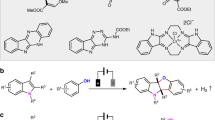Abstract
In this work, the electrochemical oxidation of catechols 1a and 1b was studied in the presence of pyrazolidine-3,5-dione (3a), as a nucleophile, in a mixture of ethanol and a phosphate buffer solution (0.1 M, pH 7), as a green medium, using the cyclic voltammetry and controlled-potential coulometry techniques. The results obtained indicated that the oxidized forms of these catechols (2a and 2b) participated in the Michael addition reactions with pyrazolidine-3,5-dione (3a), and converted, via an ECEC mechanism, to their corresponding benzofurans (7a and 7b). In this work, some new benzofuran derivatives were synthesized with good yields and high purities using a facile, one-pot, and environmentally friendly electrochemical method in the absence of any chemical catalyst, toxic solvent, and hard conditions.







Similar content being viewed by others
References
M.A. Chamjangali, M. Bakherad, M. Ameri, Electrochemical oxidation of catechol derivatives in the presence of 3-acetyldihydro-2 (3H)-furanone: efficient and green method for synthesis of new butyrolactone derivatives. Monatsh. Chem. 146, 111–117 (2015)
T. Shono, Electroorganic chemistry in organic synthesis. Tetrahedron 40, 811–850 (1984)
R.S. Ward, Lignans, neolignans and related compounds. Nat. Prod. Rep. 14, 43–74 (1997)
M. Halabalaki, N. Aligiannis, Z. Papoutsi, S. Mitakou, P. Moutsatsou, C. Sekeris, A.-L. Skaltsounis, Three new arylobenzofurans from O n obrychis e benoides and evaluation of their binding affinity for the estrogen receptor. J. Nat. Prod. 63, 1672–1674 (2000)
E.V. Angerer, C. Biberger, S. Leichtl, Studies on heterocyde based pure estrogen antagonistsa. Ann. N.Y. Acad. Sci. 761, 176–191 (1995)
C.C. Teo, O.L. Kon, K.Y. Sim, S.C. Ng, Synthesis of 2-(p-chlorobenzyl)-3-aryl-6-methoxybenzofurans as selective ligands for antiestrogen-binding sites. Effects on cell proliferation and cholesterol synthesis. J. Med. Chem. 35, 1330–1339 (1992)
G.A. Gfesser, R. Faghih, Y.L. Bennani, M.P. Curtis, T.A. Esbenshade, A.A. Hancock, M.D. Cowart, Structure–activity relationships of arylbenzofuran H 3 receptor antagonists. Bioorg. Med. Chem. Lett. 15, 2559–2563 (2005)
M. Cowart, J.K. Pratt, A.O. Stewart, Y.L. Bennani, T.A. Esbenshade, A.A. Hancock, A new class of potent non-imidazole H 3 antagonists: 2-aminoethylbenzofurans. Bioorg. Med. Chem. Lett. 14, 689–693 (2004)
C. Hocke, O. Prante, S. Löber, H. Hübner, P. Gmeiner, T. Kuwert, Synthesis and radioiodination of selective ligands for the dopamine D3 receptor subtype. Bioorg. Med. Chem. Lett. 14, 3963–3966 (2004)
Y. Hu, J.S. Xiang, M.J. DiGrandi, X. Du, M. Ipek, L.M. Laakso, J. Li, W. Li, T.S. Rush, J. Schmid, Potent, selective, and orally bioavailable matrix metalloproteinase-13 inhibitors for the treatment of osteoarthritis. Biorg. Med. Chem. 13, 6629–6644 (2005)
M.W. Khan, M.J. Alam, M. Rashid, R. Chowdhury, A new structural alternative in benzo [b] furans for antimicrobial activity. Biorg. Med. Chem. 13, 4796–4805 (2005)
O. Oter, K. Ertekin, C. Kirilmis, M. Koca, M. Ahmedzade, Characterization of a newly synthesized fluorescent benzofuran derivative and usage as a selective fiber optic sensor for Fe(III). Sensor. Actuat. B Chem. 122, 450–456 (2007)
F. Karatas, M. Koca, H. Kara, S. Servi, Synthesis and oxidant properties of novel (5-bromobenzofuran-2-yl)(3-methyl-3-mesitylcyclobutyl) ketonethiosemicarbazone. Eur. J. Med. Chem. 41, 664–669 (2006)
J. Habermann, S.V. Ley, R. Smits, Three-step synthesis of an array of substituted benzofurans using polymer-supported reagents. J. Chem. Soc. Perkin Trans. 1, 2421–2423 (1999)
D.R. Howlett, A.E. Perry, F. Godfrey, J.E. Swatton, K.H. Jennings, C. Spitzfaden, H. Wadsworth, R.E. Markwell, Inhibition of fibril formation in β-amyloid peptide by a novel series of benzofurans. Biochem. J. 340, 283–289 (1999)
J. Hardy, D. Allsop, Amyloid deposition as the central event in the aetiology of Alzheimer’s disease. Trends Pharmacol. Sci. 12, 383–388 (1991)
M. Mazloum-Ardakani, A. Khoshroo, D. Nematollahi, B.-F. Mirjalili, Electrochemical study of catechol derivatives in the presence of β-diketones: synthesis of benzofuran derivatives. J. Electrochem. Soc. 159, H912–H917 (2012)
D. Nematollahi, M. Rafiee, L. Fotouhi, Mechanistic study of homogeneous reactions coupled with electrochemical oxidation of catechols. J. Iran. Chem. Soc. 6, 448–476 (2009)
Z. Grujić, I. Tabaković, M. Trkovnik, Electrochemical syntheses of heterocyclic compounds-IV. Syntheses with nascent quinones. Tetrahedron Lett. 17, 4823–4824 (1976)
L. Papouchado, G. Petrie, R. Adams, Anodic oxidation pathways of phenolic compounds: part I. Anodic hydroxylation reactions. J. Electroanal. Chem. Interfacial Electrochem. 38, 389–395 (1972)
D. Nematollahi, M. Rafiee, A. Samadi-Maybodi, Mechanistic study of electrochemical oxidation of 4-tert-butylcatechol: a facile electrochemical method for the synthesis of new trimer of 4-tert-butylcatechol. Electrochim. Acta 49, 2495–2502 (2004)
M. Ameri, A. Asghari, A. Amoozadeh, M. Bakherad, D. Nematollahi, Green and highly efficient synthesis of new bis-benzofurans via electrochemical methods under ECECCC mechanism. J. Electrochem. Soc. 161, G75–G80 (2014)
S. Golabi, D. Nematollahi, Electrochemical study of 3, 4-dihydroxybenzoic acid and 4-tert-butylcatechol in the presence of 4-hydroxycoumarin application to the electro-organic synthesis of coumestan derivatives. J. Electroanal. Chem. 430, 141–146 (1997)
D. Nematollahi, A. Amani, E. Tammari, Electrosynthesis of symmetric and highly conjugated benzofuran via a unique ECECCC electrochemical mechanism: evidence for predominance of electrochemical oxidation versus intramolecular cyclization. J. Org. Chem. 72, 3646–3651 (2007)
M.D. Ryan, A. Yueh, W.Y. Chen, The electrochemical oxidation of substituted catechols. J. Electrochem. Soc. 127, 1489–1495 (1980)
Acknowledgement
The authors wish to thank the Semnan University Research Council for the financial support of this work.
Author information
Authors and Affiliations
Corresponding author
Rights and permissions
About this article
Cite this article
Asghari, A., Gholami, A., Bakherad, M. et al. A green, simple, catalyst-free, and efficient method for electro-organic synthesis of new benzofuran derivatives. J IRAN CHEM SOC 14, 2127–2133 (2017). https://doi.org/10.1007/s13738-017-1149-2
Received:
Accepted:
Published:
Issue Date:
DOI: https://doi.org/10.1007/s13738-017-1149-2




